Introduction: This was an 11-day family holiday with my wife Gerda and brother Tony. Gerda and I had visited 9 years ago over a slightly longer period at almost the same time, 19th Feb – 5th March 2003, but my brother had never visited the Canaries before. Our 08:30hr flight departure from Bristol cost us £140 each and lasted 3.5hrs. We had booked a hire car from the airport for the duration (£137 for 11 days) and a two-bedroomed self-catering apartment (for £350) at Caleta de Fuste, 6km south of the airport via the internet just a month before. Consequently, we only had our food to worry about upon arrival therefore minimizing time spent non-birding.
Weather: Sunny on the coast with 20-22 degrees most days after cool early morning starts. Much cooler inland and often cloudy but it never rained. Winds never moved from NE so perhaps disappointing from a migration aspect – at least we didn’t see much evidence of it.
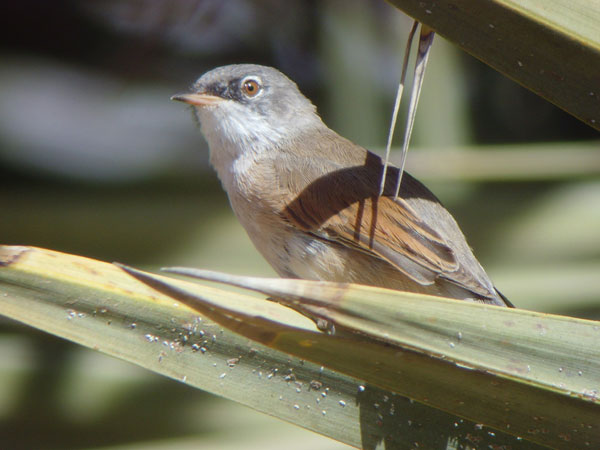
Spectacled Warbler © Dave Flumm
Comparison with 2003 visit: In the species list below, I’ve attempted to sum the total number of individuals seen on the island during our 11 days and in the brackets alongside I’ve included totals from our 2003 visit. Obviously for some species such as seabirds this is impractical but I hope for the others it gives a flavour of how abundant/scarce they are. As we visited the same areas as previously, it is interesting to compare the numbers over the nine year gap – and for some they are almost identical. Whilst this suggests their populations have remained unchanged, it should be borne in mind that there is no scientific basis for this and may be mere coincidence – but I hope it provides future visitors to Fuerteventura a measure of how likely it is to see a particular species. Where numbers are identical, it is tempting to say the same bird(s) is involved – which is unlikely to say the least - so please don’t take my comments below too seriously! We saw 64 bird species in 2003 and 71 in 2012. Those shown in italics are species only seen on the first visit.
Fuerteventura is obviously suffering from a lack of rainfall at present and Gerda and I were struck by how little greenery there was. Our photos of the landscape taken this year contrast markedly with those we took in 2003. The only greenness we found was around human habitation and of course the golf-courses where desalinated water at both is used in abundance. Otherwise the vegetation across most of the island appeared to be dead and one of the two reservoirs we visited (Embalse de las Penitas) had obviously been dry for some time. I wondered if this was why we saw so few insects this year compared to 2003 – and why we found it so hard to find Houbara (only one on our penultimate day compared with five on three days in 2003). Perhaps they are finding it difficult to breed if food is scarce?
The road network has improved tremendously too since our last visit, Presumably via a huge EU grant as everywhere we went had new tarmac – driving couldn’t have been easier.
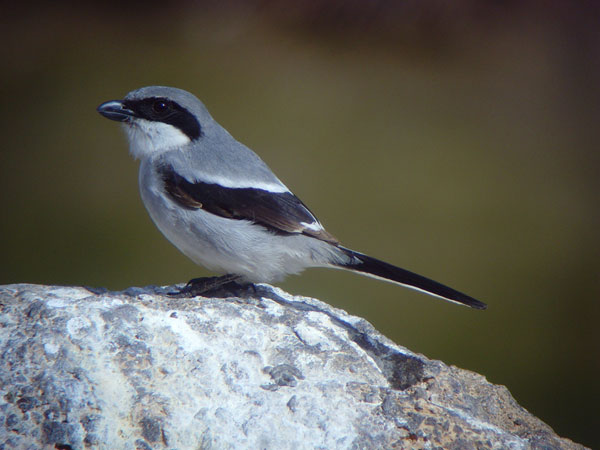
Southern Grey Shrike © Dave Flumm
The birds:
Cory’s Shearwater. 75 (105). Seen on five dates but doubtless would be seen on all if more time had been spent seawatching.
Gannet. 33 (0). All adults and all flying north off Caleta de Fuste with 25 (including a flock of 22) on 20th.
Little Egret. 16 (23). Widespread.
Night Heron. 0 (27).
Grey Heron. 9 (2). Seen at Embalse de los Molinos, Caleta de Fuste, airport and El Jable.
Spoonbill. 1 (3). One seen at Embalse de los Molinos 18th.
Ruddy Shelduck. 245 (9). Obviously they have increased!
Mallard. 15 (0). Caleta de Fuste golf course and town.
Teal. 5 (0). Embalse de los Molinos on 24th.
Marbled Teal. 0 (2).
Wigeon. 2 (0). Embalse de los Molinos 17th – 24th.
Ring-necked Duck. 2 (0). Two females at Embalse de los Molinos 17th & 18th with a single there 24th. Details sent to Spanish Rarities Committee (José Ignacio Dies Jambrino, Secretary of the Rarities Committee, CR-SEO/BirdLife) but apparently they had been there some time.
Egyptian Vulture. 12 (12). The same birds?!
Common Buzzard. 20 (17). Of the endemic island race, B.b.insularum.
Osprey. 0 (1).
Kestrel. 37 (16). Over twice as many this trip as in 2003. Of the endemic island race, F.t.dacotiae.
Barbary Falcon. 1 (0). Single hurtling through town of Pajara on 19th.
Barbary Partridge. 14 (7). Ten @ El Jable 16th and four @ Barranco de la Torre 25th.
Quail. 0 (3).
Moorhen. 13 (0). Seen only Embalse de los Molinos and Barranco de la Torre.
Coot. 196 (27). Obviously doing well in spite of the drought – but only seen on the Embalse de los Molinos reservoir and Caleta de Fuste golf course.
Houbara. 1 (5). Only one seen (at Embalse de los Molinos on 24th) in spite of constantly scanning at likely places for this species every day! Of the endemic island race, C.u.fuertaventurae.
Black-winged Stilt. 6 (0). Two at Embalse de los Molinos and four at Barranco de la Torre.
Stone-curlew. 14 (6). All at El Jable. Loose flock of 13 there on 22nd. Of the endemic island race, B.o.insularum.

Stone Curlew © Dave Flumm
Cream-coloured Courser. 9 (6). Seen at El Jable, outskirts of Puerto del Rosario and near the airport. Of the endemic island race, C.c.bannermani.
Lapwing. 1 (0). Single @ Embalse de los Molinos 17th & 24th.
Little Ringed Plover. 28 (12). Fairly widespread.
Ringed Plover. 54 (16). 30 at high tide roost at Faro de Toston, El Cortillo on 20th was the largest flock.
Kentish Plover. 15 (26). 15 at high tide roost at Faro de Toston, El Cortillo on 20th was the only flock we encountered.
Grey Plover. 1 (17). A single bird at Caleta de Fuste.
Sanderling. 53 (39).
Dunlin. 0 (1).
Snipe. 6 (1).
Black-tailed Godwit. 1 (0). Single bird at Embalse de los Molinos.
Bar-tailed Godwit. 0 (5).
Whimbrel. 7 (24).
Spotted Redshank. 0 (1).
Redshank. 4 (4). Still there.
Greenshank. 8 (9).
Green Sandpiper. 1 (1). Ditto!
Common Sandpiper. 13 (13). Is there a pattern emerging here?!
Turnstone. 13 (45).
Lesser Black-backed Gull. 200 (30).
Yellow-legged Gull. 200 (c200?). Of race L.m.atlantis.
Audouin’s Gull. 1 (0). An adult (or possibly 3rd-winter) flew north along cliffs with Lesser Black-backeds and Yellow-legged Gulls at Caleta de Fuste on 22nd @ 16:20hrs. Details have been sent to José Ignacio Dies Jambrino, Secretary of the Rarities Committee (CR-SEO/BirdLife). The surprise of the trip and a national rarity. Upon returning to England I reported the observation to Andy Paterson (mainland Spain) and am grateful to him for forwarding the details to others. Unknown to me at the time, a friend of mine, John Waldon saw an adult Audouin’s at Los Christianos, Tenerife the day before and we joked who had claimed it first (whether it was the same bird) when he phoned me about it two weeks later. There are still very few records for the Canaries which is perhaps surprising given the increasing mainland population not so far away and the pelagic nature of the species.
Black-headed Gull. 2 (0). Both @ Caleta de Fuste.
Sandwich Tern. 100 (46). Often seen on the buoys in Caleta de Fuste bay.
Common/Arctic Tern. 1 (0). Single north off Caleta de Fuste on 22nd.
Black-bellied Sandgrouse. 48 (0). All at Las Parcelas/Embalse de los Molinos stony desert area except for three at Barranco de la Torre on 25th.
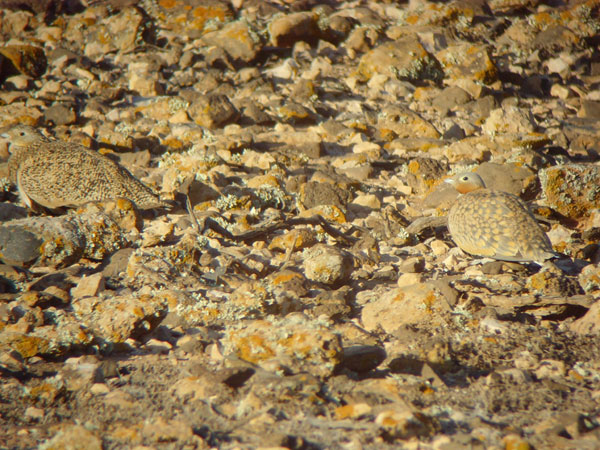
Black-bellied Sandgrouse © Dave Flumm
Rock Dove/Feral Pigeon. 550 (?)
Collared Dove. 600 (300). Perhaps a genuine increase?
Turtle Dove. 0 (3).
Laughing Dove. 1 (0). A single bird consorting with Collared Doves at Betancuria on both our visits there 17th & 23rd was a surprise – but I heard later that apparently this species is now becoming established in the islands.
Monk Parakeet. 0 (6).
Plain Swift. 37 (15).
Pallid Swift. 6 (133). Only seen at Betancuria on 17th.
Hoopoe. 23 (17).
Lesser Short-toed Lark. 160 (162). Quite a coincidence!
Swallow. 2 (10).
House Martin. 59 (12).
Berthelot’s Pipit. 150 (110).
Meadow Pipit. 4 (0). Presumed spring migrants at our apartment 23rd – 25th.
Tree Pipit. 0 (2).
White Wagtail. 85 (2). 80 on the golf course at Caleta de Fuste on 16th had all gone next day.
Grey Wagtail. 4 (0). Caleta de Fusta, Betancuria (2) and Barranco de la Torre.
Spanish Wagtail. 0 (1).
Robin. 4 (0). Left over winter visitors at Barranco de la Torre & Pajares.
Black Redstart. 3 (0). Single females at Los Molinos beach 17th, Pajares 19th & 23rd and at Embalse de los Molinos 24th. Described as a rare winter visitor but presumably overlooked.
Canary Islands Chat. 20 (15). Quite widespread although uncommon. The Barranco de la Torre was, as last time, good for this species with 3-4 pairs there.
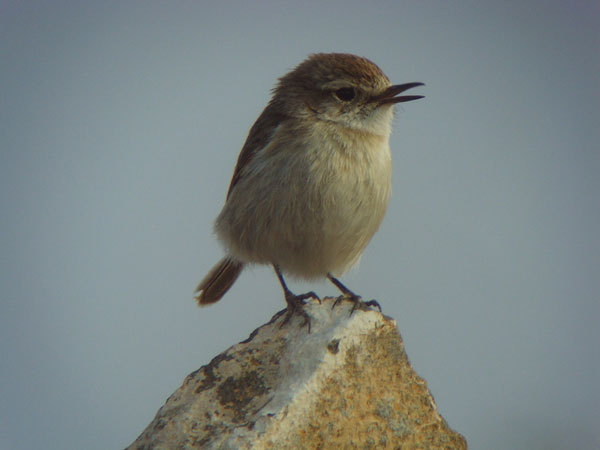
Fuerteventura Chat, female © Dave Flumm
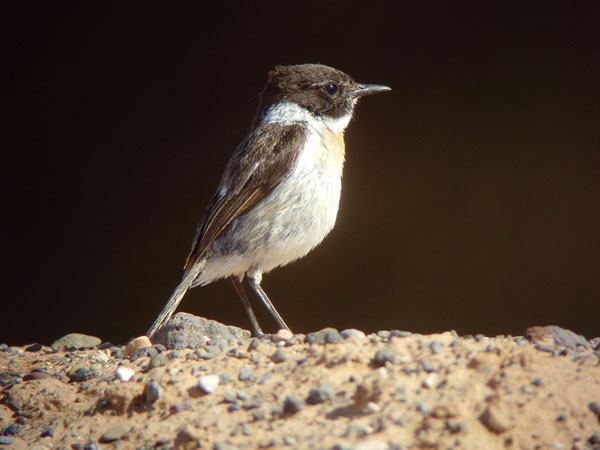
Fuerteventura Chat, male © Dave Flumm
Song Thrush. 3 (0). Two late-wintering birds at Betancuria and one at Pajara on 23rd.
Spectacled Warbler. 51 (23). Widespread. Of the endemic island race, S.c.orbitalis.
Sardinian Warbler. 17 (2). A pair at Betancuria but the inland section of the Barranco de la Torre a couple of Km from the coast was brimming with them. Race S.m.leucogastra.
Blackcap. 12 (2).
Common Chiffchaff. 15 (3).
Ultramarine Tit. 7 (5). As earlier, Betancuria and Pajara were good for this species with at least two pairs at each. I understand this former Blue Tit race has now been afforded full species status, hence the name used here, P.ultramarinus.
Southern Grey Shrike. 42 (40). No change in status? Race L.m.koenigi.
Raven. 90 (22). Probably a genuine increase. Race C.c.tingitanus.
Starling. 2 (0). Two late-wintering birds at golf course, Caleta de Fuste 16th.
Spanish Sparrow. 450 (420). Presumably no change in status and still the only sparrow on the island.
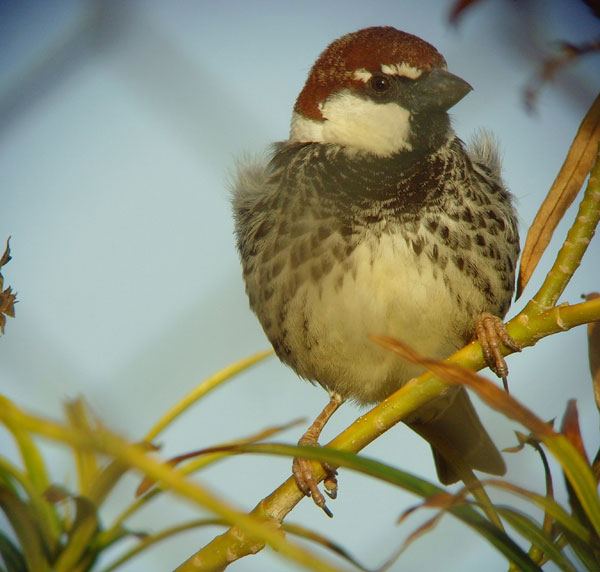
Spanish Sparrow © Dave Flumm
Goldfinch. 1 (1). It’s still there! Of race C.c.parva.
Linnet. 46 (26). Of endemic island race, C.c.harterti.
Trumpeter Finch. 112 (50). Widespread. Of endemic island race, B.g.amantum.
Corn Bunting. 0 (14).
Other
Muscovy Duck. 36 (0). At Caleta de Fuste and Los Molinos. Odd that we didn’t see any in 2003.
Red-vented/White-cheeked Bulbul hybrid. 0 (2).
Mammals
Algerian Hedgehog. Two road casualties.
Rabbit. Up to 10/day but strangely not recorded on 2003 visit.
Barbary Ground Squirrel. Widespread around coastal car parks/visitor attractions.
Reptiles
Haria lizard, Galiotia a. atlantica. Common.
Fuerteventura Gecko, Tarentola angustimentalis.
Insects
Emperor dragonfly, Anax imperator.
Painted Lady butterfly
Monarch butterfly
Small White butterfly
Bath White butterfly sp?
Ladybird, Coccinella algerica.